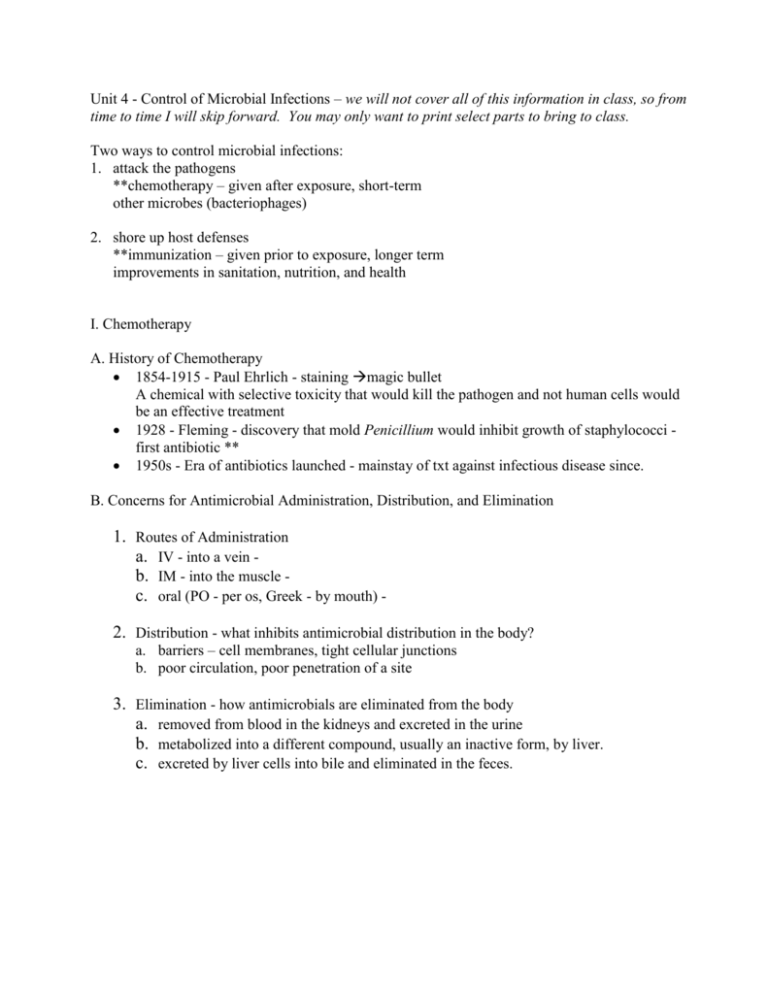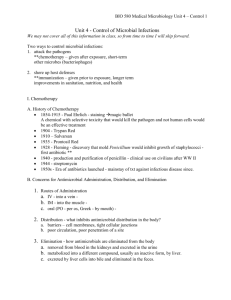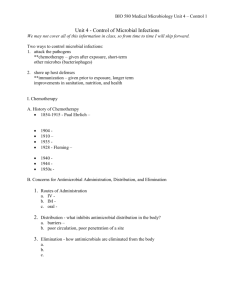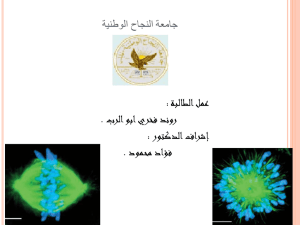BIO 580 Medical Microbiology Unit 4 - Control of Microbial Infections
advertisement

Unit 4 - Control of Microbial Infections – we will not cover all of this information in class, so from time to time I will skip forward. You may only want to print select parts to bring to class. Two ways to control microbial infections: 1. attack the pathogens **chemotherapy – given after exposure, short-term other microbes (bacteriophages) 2. shore up host defenses **immunization – given prior to exposure, longer term improvements in sanitation, nutrition, and health I. Chemotherapy A. History of Chemotherapy 1854-1915 - Paul Ehrlich - staining magic bullet A chemical with selective toxicity that would kill the pathogen and not human cells would be an effective treatment 1928 - Fleming - discovery that mold Penicillium would inhibit growth of staphylococci first antibiotic ** 1950s - Era of antibiotics launched - mainstay of txt against infectious disease since. B. Concerns for Antimicrobial Administration, Distribution, and Elimination 1. Routes of Administration a. IV - into a vein b. IM - into the muscle c. oral (PO - per os, Greek - by mouth) 2. Distribution - what inhibits antimicrobial distribution in the body? a. barriers – cell membranes, tight cellular junctions b. poor circulation, poor penetration of a site 3. Elimination - how antimicrobials are eliminated from the body a. removed from blood in the kidneys and excreted in the urine b. metabolized into a different compound, usually an inactive form, by liver. c. excreted by liver cells into bile and eliminated in the feces. 2 C. How Antimicrobial Agents Work Antimicrobials are classified by three different classification systems used simultaneously: 1. microbicidal or microbistatic - whether they kill or inhibit the growth -static is reversible, -cidal is not 2. by site of action of the drug 3. by chemical structure Antimicrobial agents organized by site of action - Know site of action for the antibiotics from lab **5 Sites of Action (or targets) of Antimicrobials 1. Cell wall synthesis 2. Cell membrane function 3. Nucleic acid synthesis or replication 4. Bacterial ribosome and protein synthesis 5. Metabolic pathways 1. Inhibit cell wall (i.e. peptidoglycan)l synthesis Can inhibit peptidoglycan synthesis in two different manners: a. inhibit synthesis of the linear strands of peptidoglycan b. inhibit cross-linking between the strands 2. Disrupt cell membrane function a. phospholipids of gram negative bacteria b. sterols of eucaryotic fungi - ergosterol 3. Inhibit nucleic acid synthesis or replication a. inhibit DNA gyrase – prevent relaxation of supercoiled DNA during replication b. inhibit bacterial RNA polymerase mRNA synth 4. Inhibit protein synthesis by interfering with bacterial ribosome – either 30S or 50S 5. Inhibit metabolic pathways Ex. Two antimicrobial agents inhibit folic acid synthesis: 3 Antimicrobial agents organized by drug family – Know drug family for the antibiotics from lab A. Anti-Bacterial Agents – I will only cover a few of these in class Usually an antibiotic – a natural substance secreted by one microbe that inhibits the growth of another microbe. 1. Inhibitors of cell wall synthesis (Figs. 33.6, 33.8) *Beta-lactams – antibiotics containing a beta-lactam ring a. Penicillins – end in “illin” b. Cephalosporins – begin with “ceph” or “cef” Mode of action – inhibit cell wall synthesis by binding any of a group of membrane proteins collectively called penicillin-binding proteins (PBP) –that are involved in crosslinking the peptides of peptidoglycan activate cell lysis (-cidal) Administration route – IM, IV, PO (some semi-synthetics have been produced to be acid stable) Distribution in the body – cross membranes, incl. BBB Mechanism of elimination – kidneys urine (rapid) Special uses –most heavily used family – but only effective against bacteria with cell walls Adverse side effects – Generally very low toxicity. Type I hypersensitivity (rare), rashes, some bacteria develop -lactam resistance during the course of txt. Examples - penicillin, ampicillin, amoxicillin, methicillin cephalothin, cephalexin, cefaclor (highlight the ones from lab) 2. Inhibitors of cytoplasmic membrane function Polymyxins Mode of action – detergents that disrupt phospholipid structure Administration – topical Uses – Gram negatives except Proteus Examples – Polymyxin B 3. Inhibitors of protein synthesis (Fig. 33.10) Aminoglycosides – end in “mycin” or “micin” Mode of action –1) irreversible binding to 30S subunit of ribosome no initiation complex no protein synthesis. 2) misreading of mRNA defective protein (-cidal) Administration –IV – not well absorbed orally because + charged, don’t cross membranes Distribution – blood and fluids – can’t cross membranes Elimination – kidneys urine Uses – serious systemic GN in hospitalized patients Side effects – very toxic – most toxic of all commonly used antibiotics – fine line between therapeutic doses and toxic doses – can result in irreversible damage to inner ear (loss of hearing/balance) and kidneys. Examples – streptomycin (was a major anti-TB drug), gentamicin (broad spectrum), amikacin, neomycin 4 Tetracyclines – end in “cline” (although brand names may end in “mycin”, like Vibramycin) Mode of action reversible binding to 30S blocks A site on ribosome (-static) Administration – PO, well-absorbed Distribution - broadly distributed in the body, intracellular. Elimination – through kidneys to urine and bile to feces Uses – very broad spectrum – G+, spirochetes, mycoplasma (don’t have peptidoglycan), intracellular (chlamydia, rickettsia) Side effects: GI upset - partly due to direct irritation of GI by the drug, partly due to rapid drug-induced changes in normal gut microbiota diarrhea. Children – interacts with Ca 2+ in developing bones and teeth, can permanently stain the teeth, so not given to children or pregnant women. Organ damage – systemic administration can result in liver and kidney damage. *Added to animal feed - resulting in widespread tetracycline resistance Examples – tetracycline, oxytetracycline, doxycycline Chloramphenicol Mode of action –reversible binding to 50S – prevents action of peptidyl transferase and peptide bond synthesis (-static) Administration – PO, IV, topical Distribution – crosses membranes incl. brain, eye, and cellular Elimination – metabolized in liver inactive form kidneys to urine Uses – broad spectrum; G+, G-, aerobes and anaerobes, intracellular Side effects – pretty toxic, used only when other antibiotics are not effective. Disrupts protein synthesis in bone marrow bone marrow suppression, which is dose-dependent and reversible. May also result in aplastic anemia, which is dose independent, irreversible, and fatal. Develops days to weeks after txt stops (rare). Macrolides, lincosamides - mycin Mode of action –prevents release of tRNA (-static) Administration – IV, PO Distribution – well distributed except into CSF or intracellular Elimination – liver bile feces Uses – mainly G+, an alternative to b-lactams Examples: Macrolide - Erythromycin - best known and most widely used. Binds to 23S rRNA & blocks release of tRNA. Fairly safe, low toxicity, but resistance may develop rapidly during txt. Lincosamide - Clindamycin – inhibits peptide bond formation. Active against many anaerobes. Assoc. with pseudomembranous colitis, caused by an overgrowth of Clostridium difficile in the wake of widespread destruction of normal gut microbiota. 5 Inhibitors of Nucleic Acid Synthesis Inhibit DNA replication - Quinolones Mode of Action – inhibit DNA gyrase & topoisomerase (-cidal) Administration - PO Distribution – crosses membranes Elimination – kidneys urine Uses – UTI (esp. ciprofloxacin), systemic infections by Enterobacteriaceae. Side effects – GI, also inhibits cartilage development so not given to children, pregnant or lactating women. Examples - (nalidixic acid), norfloxacin, ciprofloxacin Block synthesis of mRNA – rifamycins Mode of Action – binds to DNA-dependent RNA polymerase (-cidal) Administration - PO Distribution – crosses membranes, reaches high conc in saliva Elimination liver __> bile feces Uses mycobacterial infections Side effects – rashes and jaundice Examples - rifampin Antimetabolites - Sulfonamides - synthetic Mode of action – structural analogs of para-amino benzoic acid (PABA) results in inhibition of folic acid synthesis (-static) Administration - PO Distribution – well absorbed and distributed widely in fluids and tissues. Elimination – inactive compound, kidneys urine. Uses – broad spectrum, G- except . aeruginosa. Standard for UTI in combination with trimethoprim. Side effects – relatively free of toxic effects Example – Sulfamethoxazole (GantanoleR) 6 B. Anti-Fungal Agents - Fewer in number - Selective toxicity more difficult – superficial infections respond well to topical antifungals but systemic fungal infections are challenging to cure. I will only cover Amphotericin B in class Examples: 1. Azoles – lots of them Mode of action – inhibit the synthesis of ergosterol Uses – skin and deep systemic mycoses Exs. miconazole, ketoconazole, fluconazole IV PO PO or IV 2. Polyenes – produced by Streptomyces Ex. Mode of action - Nystatin Amphotericin B Both bind to ergosterol in the fungal membrane K+ leakage cell death Administered - Topical IV Uses - Poor penetration into fluids. Used for serious systemic infections such as cryptococcal meningitis, histoplasmosis. Side effects - Universal febrile high fever, chills, hypotension, nausea, vomiting, dyspnea, tachypnea. Nephrotoxicity permanent kidney damage in 80% of treated patients. Hepatotoxicity, cardiac arrhythmias, cardiac failure 3. Griseofulvin – from Penicillium Mode of action – impairs mitotic spindle inhibits fungal cell division Uses – dermatophytes onlys – a 1st line txt but being replaced by newer antifungals like the azoles. 7 C. Anti-Viral Agents – Development of antiviral chemotherapy has lagged behind the others but has been spurred by HIV/AIDS (1/2 of all antivirals are for HIV). Since viruses use host structures and enzymes for replication, inhibiting viral replication without toxicity to the host is difficult. All are virustatic. I will not cover examples in class Targets for antivirals – in theory, any step from attachment & entry exit. 1. Target viral DNA polymerase Ex. Aciclovir (ZoviraxR) Uses – herpes, varicella infections – to prevent reactivation & encephalitis – cannot resolve latent infections – not a cure. 2. Inhibitors of reverse transcriptase - retroviruses including HIV (RNA DNA) Ex. AZT = Azidothymidine (Zidovudine, RetrovirR) Mode of action – analogue of thymidine, interferes with reverse transcription. Administration – PO Uses – slows the progression of immune failure. Given to pregnant women so they won’t pass HIV to their fetus. Side effects –bone marrow toxicity Never use in monotherapy. 3. Inhibitors of viral proteases formation of defective HIV Never use in monotherapy due to risk of developing resistance. 4. Antivirals targeting Influenza viruses Ex. Amantadine Mode of action –prevents fusion of viral envelope with cell membrane Administration – PO – 2-4 hrs to peak blood levels. Uses – Txt of influenza A if given w/in 48h. Prophylaxis for high risk patients. Side effects – insomnia, dizziness, headache, psychoses. Ex. Oseltamivir Mode of action – inhibits neuraminidase Use – also effective against H5N1 (avian influenza) *** Often there is a lot of toxicity with anti microbial drugs!!! Also, development of drug resistance in the microbe is a problem! 8 D. Antimicrobial Resistance 1. Perspective (any notes you want to make here) 2. Development of antimicrobial resistance Primary resistance - Modification of existing genetic material via spontaneous mutation - passed vertically from parent to offspring Acquired resistance - genetic material is transferred between individual bacteria = Horizontal Gene Transfer (HGT) transformation transduction conjugation ***3. Relationship between microbial burden, clinical symptoms, and antibiotics (understand well!!!) (sorry the graphs did not copy over very well) 9 10 11 12 4. The scope of the problem (any notes you want to make) 5. Combating antibiotic resistance a. Decrease prescription antibiotics to small children b. Large scale public education efforts c. Regulate antibiotic use in animal feed d. What about remove antibiotic until bacteria lose the acquired resistance? Once thought that resistance to antibiotics was traded for reduced fitness, so growth rates would be slower – not so, often no reduced fitness. e. Step up the search for new, very different antimicrobial products II. Immunization Used to protect individuals prior to exposure. The point of Immunization (how it works) – draw diagram Goal may be to block transmission, prevent symptoms, or eradicate disease. A certain percentage of the population will need to be immune to interrupt disease transmission. The greater the number of persons 1 infected individual can infect, the more difficult the disease will be to control. 13 Types of Vaccines - Important 1. Live (but attenuated) – whole agent but weakened in the lab Pros Mimics a natural infection – enters at same site, multiplies, providing longer term antigenic stimulation Good instruction of immune response strong antibody (IgG) and cellular response Long lasting Spreads among close contacts. Cons Agent can mutate and revert to virulent so contraindicated in immunocompromised and pregnant Requires refrigeration to retain potency Exs. Smallpox (heterologous), Influenza nasal (FluMist), MMR, Varicella, yellow fever, OPV (oral polio virus). 2. Inactivated (but whole, intact) – produced by killing agent with heat, chemicals, or radiation Pros Induces pretty good immune response with IgG and IgA No reversion to virulent, can use in immunocompromised Doesn’t req. refrigeration, easily stored and transported. Cons Stimulates CMI only poorly Immunity is not long lasting, req. boosters Does not spread to close contacts Increased risk of allergic responses (chemicals) Exs. Influenza injected (TIV), Hep A, IPV, anthrax 3. Subunit- instead of whole agent, only the antigens that best stimulate the immune system Pros - Very safe Cons – tricky to find the correct antigen Exs. Subcellular polysaccharides – Hib, PVC, MCV4 stimulate opsonizing IgG; acellular – aP, HPV; toxoid - D, T 14 Timing of vaccination - Vaccination schedules for various age groups can be found at http://www.cdc.gov/vaccines/recs/schedules/default.htm Recommended Childhood Immunizations (Ages 0-6 years) – Updated 2010 - I will only point out a couple of important points 1. HepB – Hepatitis B – at birth 2. RV – Rotavirus – 6 weeks 3. DTaP – Diphtheria-Tetanus-acellular Pertussis – 6 weeks 4. Hib – Haemophilus influenzae type B – 6 weeks 5. PCV – Pneumonococcal (Streptococcus pneumoniae, polysaccharide capsule strains that infect children) – 6 weeks 6. IPV – Inactivated Poliovirus – 6 weeks 7. Influenza – seasonal – 6 months for TIV, 2 years for LAIV 8. MMR – Measles Mumps Rubella – 12 months 9. Varicella – Chickenpox – 12 months 10. HepA – Hepatitis A – 12 months 15 Recommended Adult Immunizations – Updated 2010 – see handout for details, I will only point out a couple of important points 1. Td/Tdap – Tetanus diphtheria/Tetanus diphtheria acellular pertussis – 1 booster every 10 years 2. HPV – Human papillomoavirus – all females to age 26 (vaccine for men is in development) 3. Varicella – everyone who lacks immunity 4. Zoster – age 60 5. MMR – Measles, mumps, rubella – anyone 19-49 who is not immune 6. Influenza – everyone every year 7. Pneumonococcal – everyone over 65 (those polysaccharide strains of S. pneumoniae that infect adults, different strains than in the childhood vaccine) 8. Hep A, Hep B, Meningococcal – certain “at risk” groups 9. Others for overseas travelers, military. There is a lot of mis-information about vaccines and vaccine safety out there. There are sites that I believe to be the most reputable. Information on vaccines and vaccine safety can be found at the following sites: On-line quiz, what vaccinations do you need? http://www2a.cdc.gov/nip/adultImmSched/ Vaccine Side Effects http://www.cdc.gov/vaccines/vac-gen/side-effects.htm Vaccine Adverse Event Reporting System http://www.cdc.gov/vaccinesafety/Activities/vaers.html FDA http://www.fda.gov/BiologicsBloodVaccines/Vaccines/default.htm







